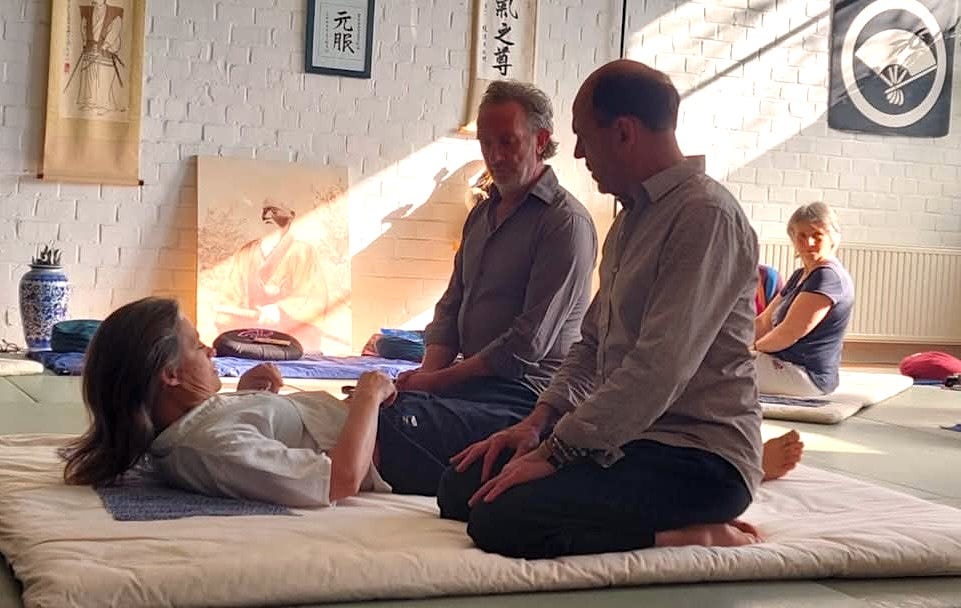Onset
In the late summer of 1986, in Dali, a delightful town in the mountains of South West China, I unwittingly stumbled upon Taiji Chuan and Qigong. I was in the middle of an extended trip through Asia and in a state of debilitation and near exhaustion, due to a month of travelling in extreme conditions and meagre nutrition, a recent series of catastrophic digestive problems and a bout of hepatitis the previous year. I was not looking for anything and in fact merely wanted to be left alone to lick my wounds in peace.
Life, providence or the universe had quite other plans for this little wanderer.
Firstly, I met a charming and graceful elderly gentleman teaching Taiji at the very hotel I was staying at, who roused me every morning through my window with the softly spoken question: “study Taiji…?” and who initiated the practice of the sequence with the gentle command: “Began”.
Secondly I was also the grateful recipient of a wonderfully rejuvenating form of bodywork, which in retrospect transpired to be a Chinese version of Shiatsu. Performed on a table and with the help of a Menthol- and Winter Green-based liniment, the treatments were delivered by a deaf mute with sparkling eyes, bulging biceps and an eye for a prospective student.
Continuation
From that moment on, these transformational art forms became my vehicles for exploration of the world within and around me. The study of these movements, postures and techniques rapidly took over my life and led me into the joy of Shiatsu and acupuncture, which have formed the basis of my profession to this day. Studies of martial arts, Qigong, Chinese herbal medicine and the art of food energetics rounded out the picture.
I found myself embedded in a worldview based on the principles of energy flow, yin-yang polarity and five phase dynamics. I quickly realised that these could be applied to any conceivable situation, no matter how complicated and irrespective of level – physical, mental, emotional, spiritual – with astounding clarity. My study, my playtime, my work and my life became inseparably intertwined and integrated into one long voyage of discovery. The voyage has continued to this day and shows no signs of slowing up, still less stopping.
That is not to say that the voyage has always been easy or without pain – at times excruciating, nerve wracking pain. Some of the pain has been physical, for example while standing for long periods in seemingly impossible stances for martial arts training. Some of the discomfort has been of the mental variety; trying to integrate apparently contradictory sets of information from otherwise compatible approaches like Shiatsu and acupuncture. At times, the pain has been of the existential variety when faced with apparent rejection from a respected Taiji teacher before a new one had presented himself.
A Sense of Returning
But there has always been a sense of returning. Returning to what? The journey seems to be a circular one, or rather one of spirals. One embarks on a line of thought, study or activity and the line inescapably turns around and back on itself towards a point of origin, which gets brighter and clearer each time… and more joyful.
Like everyone else around me, I am in the midst of a process, which has no beginning and no end. Different people accompany me through different periods and for differing lengths of time. Some disappear for a while only to reappear unexpectedly in a new context. Reminders come through all kinds of media – books, films, dreams, memories and meetings – and reveal the extent of the learning process and some of its important stages or omissions.
The Journey Spirals on
Taiji, Qigong, Shiatsu and acupuncture have formed the base of my practice for almost four decades. Perhaps surprisingly, they reveal themselves in a new light time and time again. A typical micro-process, which seems to occur with relative frequency, is the dynamic shift between complexity and simplicity. The journey leads into oceans of detail and shades within nuances, only to empty out into huge vistas of simplicity with broad strokes and clear lines. Simplicity reveals itself when complexity is exhausted and then complexity begins once more to increase as wheels turn anew.
Within this process of spiralling interchange between simplicity and complexity, another pair of complementary opposites has revealed itself over time. Quite paradoxically, form and improvisation also turn out to be comfortable bedfellows.
Form and Improvisation - Comfortable Bedfellows
The learning of forms yields to areas of freedom where the body and the mind are guided into new levels of ease and grace. I am sure many have experienced what I am referring to here: we find room for small variations and notice our own peculiar footprint, which remains unique and relatively constant despite shifting surroundings. Through repeated practice, we plunge forwards into new depths of structure and form, and once again relish the increased capacity this produces.
We feel, perhaps, a new ease growing within the patterns of the form and discover the internal space this opens up. With internal expansion comes a corresponding widening of external spatial perspective - our world expands continually both inwards and outwards. One thing catalyses another and the process produces an increased creative drive, which yields its own peculiar, sometimes even original perspectives. Thus: improvisation.
For most of us, this will reveal itself only in minor details at first. However, with repeated practice and close examination of details, the potential range for new insights, alternative movements, variations in technique and ultimately wholly new forms expands. This is aided by the gradual integration of technique into the layers of body memory and the deep work conducted at times of rest, relaxation and even sleep.
This text is adapted from:
The Poetry of Touch: Alchemy, Transformation and Oriental Medicine (https://www.fyrfalk.se/the-poetry-of-touch-by-chris-mcalister/)



